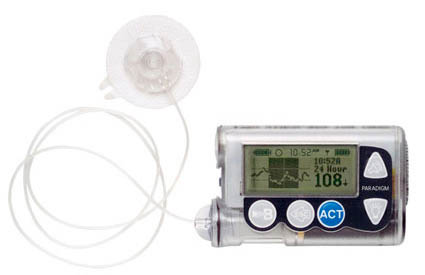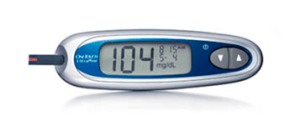My treatment: The hardware
On a daily basis, I use three devices to control my diabetes: an insulin pump, a continuous glucose monitor (CGM) and a standard blood glucose monitor.
1. Insulin Pump
Brand/Model: Medtronic Paradigm 522
My insulin pump delivers Humalog insulin through a tube connected to one of the needles in my stomach. Insulin delivery is programmed two different ways. Basal rates, preset hourly dosages, are delivered automatically. Meanwhile, I program bolus dosages manually to cover meals or to correct my blood sugar level.
2. Continuous Glucose Monitor (CGM)
Brand/Model: Medtronic MiniLink REAL-Time Transmitter
A second needle in my stomach is a sensor for my CGM. This reads my blood sugar level every 5 minutes and transmits the data wirelessly to my insulin pump. It tests in interstitial fluid (the fluid in between cells), not blood. The readings lag actual blood sugar level readings by about 15 minutes because it takes time for changes to reach the interstitial fluid.

On the left is a CGM sensor before it is inserted. On the right, the sensor with the CGM transmitter attached.
3. Blood glucose monitor
Brand/Model: OneTouch UltraMini
I still need to test my blood sugar by pricking my finger, taking a drop of blood and testing it in a standard blood glucose meter. These readings are considered more accurate than a CGM reading. The CGM also needs to be calibrated a few times a day by telling it my most recent blood glucose reading. On average, I test about 8 times a day.
Managing all these devices
I have been using an insulin pump for 24 years, so I am pretty used to them. Pumps tend to break every few years (surprisingly just after the warranty ends) and each new model has some new features. But by and large, the machine is the same. This is expected to change in the coming years as the CGM and pump start working closer together and actually start controlling the insulin dosages automatically.
I have been using a CGM for only about a year and a half now. The machines definitely take some getting used to. They can be amazingly accurate at times and go completely wild at other times. Also, the 15 minute data lag time in the CGM reading must be balanced against insulin lag time. Wired magazine described it well here:
Adding to the difficulty is the lag between a diabetic’s current blood-sugar level and the readings transmitted by the glucose monitor, not to mention its margin of error. Moreover, once the insulin is released, it takes at least 15 minutes to begin lowering sugar levels, reaches peak efficiency after 45 minutes, then continues working less and less efficiently for another three hours. So the job of the automated insulin-dispensing system can be likened to navigating a car down a winding road when you’re unable to see the curves until you’re 15 yards past them — and turning the steering wheel has no effect for another 200 yards. ( http://www.wired.com/magazine/2010/04/ff_pancreas/all/1)
That said, I still prefer having all the extra CGM data to not having it. I think there is tremendous potential in using this data to improve patient control and gain a more precise understanding of various factors including foods, exercise and more. I plan on talking much more about this in the coming months.



You must be logged in to post a comment.